Exploring the Depths of Improvised Musical Performance


Intro
Improvised musical performances represent a unique crossroad of creativity and spontaneity. This art form transcends mere notes and rhythms; it is an exploratory journey so deeply embedded in various cultural rhythms and historical contexts. Understanding this landscape requires a close examination of its roots as well as its dynamic nature in contemporary settings. Musicians across genres engage in a dialogue that reflects both their individual styles and the collective experience of the audience. This article aims to unpack these layers, offering insights into the past, present, and future of improvisation in music.
Technology Insights
Latest Tech Trends
In the realm of improvised performance, technology plays a pivotal role. Electronic instruments, digital audio workstations, and software tools like Ableton Live or Logic Pro have radically transformed how musicians approach improvisation. The integration of technology allows for real-time manipulation of sound, enabling artists to experiment and express without conventional limitations. Live looping devices, for instance, empower performers to layer sounds on-the-fly, creating a richer sound tapestry.
Innovation in Tech
Innovative tools continue to emerge that enhance the improvisational experience. For example, MIDI controllers and plugins offer musicians an abundance of sounds and effects to explore. The rise of applications tailored specifically for musicians, like Boss Tone Studio or JamKazam, enables collaboration across distances, bridging gaps that once hindered live, improvised performances. These advancements stimulate creative expression while introducing new possibilities for interaction among artists.
Product Reviews
When discussing technology in improvised musical performance, it is essential to highlight specific products that have made an impact:
- Akai Professional MPC Live II: Known for its portability and flexibility, this device enables musicians to create and manipulate loops in real time.
- Roland SP-404SX: Valued for its simplicity and immediacy, this sampler allows for quick sampling and performance in live settings.
Both products showcase how technology can open new avenues for creativity and exploration in improvised music.
Artistic Techniques
Understanding the techniques employed by musicians in improvisation can offer valuable insights. Some fundamental approaches include:
- Call and Response: This technique involves musicians responding to each other's phrases, creating a conversational dynamic.
- Motivic Development: Musicians often take small musical ideas and develop them throughout the performance.
- Polyrhythms: Combining different rhythmic patterns can add layers of complexity and interest to the performance.
These techniques are essential to fostering a collaborative atmosphere, allowing musicians to unite their creative energies.
Audience Engagement
An often-overlooked aspect of improvisation is its impact on audience engagement. The spontaneity and unpredictability inherent in these performances create a shared experience between the musicians and their listeners. Audiences are more than passive observers; they react and interact with the live performance, influencing the direction of the music. This connection can deepen the emotional resonance, creating a memorable experience for everyone involved.
The End
Understanding Improvised Music
In the exploration of improvised music, it is essential to grasp its fundamental aspects. Understanding this concept paves the way for appreciating its applications in various genres and cultures. Improvised music serves as the catalyst for spontaneous creativity. This section aims to break down its definition, historical significance, and cultural implications, illustrating how these elements intertwine to form a rich tapestry of artistic expression.
Definition of Improvised Music
Improvised music refers to the act of creating music spontaneously during a performance. Musicians compose, interpret, and manipulate sounds in real time without predefined structures or scripts. This contrasts sharply with traditional forms, where compositions are rigorously planned and rehearsed. At its core, improvisation represents freedom and individual expression, allowing artists to showcase their technical skills while also reflecting their emotional states.
In various genres such as jazz, blues, and contemporary classical music, improvisation can take many forms. It can range from simple variations on a theme to complex dialogue between musicians. Improvised music often emphasizes individuality and uniqueness in each performance, presenting listeners with experiences that are never quite the same.
Historical Overview
The history of improvised music stretches back through centuries, intertwining with many cultural traditions. Ancient civilizations engaged in early forms of music creation sans structures, where improvisation was often the norm. In Western music, particularly during the Renaissance and Baroque periods, musicians frequently practiced improvisation both in compositions and performances.
The emergence of jazz in the early 20th century marked a turning point in the practice of improvisation, establishing it as a central pillar of the genre. Musicians like Louis Armstrong and Duke Ellington propelled jazz into the mainstream, showcasing improvisation's potential to convey complex emotions and intricate ideas. The late 20th century saw a resurgence in various forms of improvisation, from improvisational rock to avant-garde classical music.
Cultural Significance
Improvised music plays an important role in cultural expression. Many cultures around the world utilize improvisation as a means to convey heritage, identity, and social commentary. For instance, in African music traditions, improvisation often accompanies storytelling, enhancing the connection between performer and audience. Similarly, in Indian classical music, improvisation within raga frameworks allows musicians to explore themes of spirituality and cultural narratives.
Furthermore, improvised music fosters community engagement and collaboration, breaking down barriers between performers and listeners. It invites them to share creative spaces, shaping a unique experience for everyone involved. This interaction results in a dynamic cultural matrix, reflecting the evolving landscape of contemporary music.
"Improvised music acts as a mirror to society, reflecting its joys, sorrows, and complexities in real time."
Theoretical Foundations


Understanding the theoretical foundations of improvised musical performance is essential for grasping the nuances of this art form. These foundations provide the framework within which musicians can explore their creativity while adhering to certain musical principles. The interplay between structure and spontaneity is crucial for effective improvisation. Musicians need to be able to recognize the established norms of their chosen musical styles but also feel liberated enough to express their individuality.
Musical Structures and Improvisation
Musical structures have a significant role in improvisation. Familiarity with scales, chords, and song forms helps musicians navigate their musical landscape. For instance, a jazz musician often improvises within a framework based on a standard chord progression. This allows exploration within a defined boundary, ensuring that the improvisation is coherent and aural.
Key concepts include:
- Chord Progressions: Musicians often improvise by following or altering existing harmonic sequences, which can evoke emotional responses.
- Form Patterns: Common forms like AABA in jazz serve as reference points, allowing improvisers to craft solos that make sense musically.
Improvisation thrives on coherence. Without some structural understanding, the result can often be chaotic or uninspired.
Harmony and Melody in Improvised Music
Harmony and melody are two sides of the same coin in improvisation. While melody is often the most recognizable aspect of music, harmony adds depth and color. Improvisers manipulate melodies over underlying harmonies to create engaging musical conversations. This interaction can establish tension and release, guiding listeners through the emotional landscape of the piece.
In the realm of improvisation, chord tones are significant. Musicians often focus on target notes within a chord to create melodies that feel intentional. Melodies are crafted based on:
- Scalar Choices: Aligning melodic phrases with underlying chords using appropriate scales.
- Non-Chord Tones: Use of passing tones and neighbor tones that provide movement and complexity.
Understanding this interplay significantly enhances the improvisation process, enriching the overall musical experience.
Rhythm and Time Signatures
Rhythm serves as the heartbeat of music. In improvisation, competence in various time signatures allows musicians to break the rules and yet maintain a sense of musicality. Rhythm is not just about keeping time; it involves expressing musical ideas through syncopation, polyrhythms, and variations in tempo.
Time signatures can vary dramatically across genres, with some examples including:
- 4/4: Common in genres like rock and pop, providing a straightforward, steady drive.
- 5/4 & 7/8: Found in jazz and progressive music, these signatures create a level of unpredictability that can challenge and excite both performers and listeners.
The importance of rhythm in improvisation cannot be overstated. It's the element that often captivates the listener first, aligning all musical expressions into a cohesive whole.
Improvisation Techniques
Improvisation techniques are crucial in understanding the breadth of improvised musical performance. These techniques establish the foundation informing how musicians interact, express creativity, and respond to each other in real-time. There are several key elements worth considering, such as the balance between structure and spontaneity, the dynamics of collaboration, the role of instruments, and the nuances of vocal improvisation. Each of these aspects contributes significantly to the artistic experience and to the overall atmosphere of a performance.
Free Improvisation vs. Structured Improvisation
Free improvisation is often characterized by a lack of predetermined structure. Musicians can explore sounds and expressions without constraints. This allows for high levels of creativity and personal expression. On the other hand, structured improvisation imposes certain guidelines or frameworks, such as chord progressions or rhythms. This framework can provide a safety net, allowing musicians to take risks while maintaining some coherency within the performance.
- Key Differences:
- Benefits of Each Approach:
- Free improvisation encourages spontaneity and raw creativity.
- Structured improvisation emphasizes coherence and interaction within defined limits.
- Free improvisation can lead to unique and unexpected musical landscapes.
- Structured improvisation allows for more collaboration, as musicians have a common frame of reference.
Collaborative Improvisation Dynamics
Collaboration is essential in improvisation. Each musician brings their own ideas, backgrounds, and skills to the group. This interplay can create rich and nuanced musical dialogues. Dynamic listening becomes crucial, where participants must be attentive to each other's contributions. Collaborative improvisation fosters communication, requiring musicians to adapt and respond to the evolving musical conversation.
- Effective Collaborative Improvisation:
- Active listening.
- Mutual respect for each other’s input.
- Flexibility to change direction based on group dynamics.
"Improvisation is not merely a spontaneous act but a dialogue that unfolds in the moment, shaped by individual expressions and collective energy."
Instruments and Their Role
Instruments play a significant role in improvisation, impacting the style and texture of the music produced. Each instrument has its own character and range, contributing to unique sounds. Musicians may choose instruments based on their versatility and ability to blend with others. For example, a saxophone can provide melodies, while drums can enhance rhythm and drive the pace.
- Considerations When Choosing Instruments:


- Individual expressiveness of the instrument.
- Compatibility with other instruments in the ensemble.
- The desired overall sound and style.
Vocal Improvisation Techniques
Vocal improvisation introduces a distinct layer to improvised performances. It allows for both melodic and rhythmic expression through the human voice. Techniques can vary widely among performers. Some may use scat singing, using nonsensical syllables to create rhythm and melody. Others may incorporate spoken word or utilize breath control and pitch variations.
- Vocal Techniques to Explore:
- Scat singing for rhythm and melody improvisation.
- Use of call and response forms to engage others.
- Experimentation with dynamics to convey emotion.
Genres Incorporating Improvisation
Improvisation plays a vital role in various musical genres, shaping their identity and expressive capabilities. Understanding these genres provides insight into how improvisation affects musical communication, collaboration, and creativity. Exploring genres that embrace improvisation opens new perspectives on the dynamics between musicians and audience, highlighting the improvisation's intrinsic value in diverse musical expressions.
Jazz and Its Subgenres
Jazz stands as one of the most prominent genres where improvisation shines. Rooted in African American culture, jazz musicians often engage in collective improvisation. This spontaneity gives rise to unique performances that vary from night to night. Artists like Louis Armstrong and Miles Davis pushed boundaries, creating subgenres such as bebop and smooth jazz. These subgenres offer distinct improvisational styles that maintain communication among players while challenging traditional forms.
Blues and Improvisation
Blues music is deeply intertwined with improvisation, often showcasing emotional expression and storytelling through music. This genre allows musicians to deviate from structured melodies and explore personal experiences. Artists like B.B. King and Muddy Waters have demonstrated the significance of blues improvisation. Guitar solos and vocal embellishments highlight the artist's feelings, connecting performer and listener on an emotional level. The emphasis on improvisation within blues encourages authenticity in performance.
World Music Influences
Various global musical traditions incorporate improvisation, reflecting local cultures and aesthetics. For example, Indian classical music emphasizes ragas, which serve as frameworks for improvisation. Similarly, in African music, call-and-response patterns invite participatory improvisation among musicians. Each culture contributes unique improvisation techniques, enriching the global musical tapestry. Understanding these influences broadens the scope of improvisation beyond Western contexts, revealing its universal appeal.
Contemporary Classical Music
In recent years, contemporary classical compositions have also started embracing improvisation. Composer John Cage and performers such as the improvisational cellist Matt Haimovitz explore spontaneous music-making within classical environments. This genre challenges conventional notions of performance, allowing for greater freedom and interpretation. The cross-pollination of improvisation in contemporary classical music underscores its evolving nature.
Rock and Experimental Genres
Rock music has seen significant improvisation, especially within subgenres like jam bands and progressive rock. Bands such as the Grateful Dead and Phish have made extended improvisation a hallmark of their performances, inviting fans to experience unique musical journeys each show. Similarly, experimental music often challenges traditional structures, focusing on sound exploration and improvisational techniques. The freedom in these genres fosters innovation, encouraging musicians to push boundaries and redefine what music can be.
Improvisation is not just an act of creation; it reflects the depth of communication between musicians and the context of their performance.
The Role of Audience in Improvised Performances
Improvised musical performances often exist in a dynamic relationship with the audience. This interaction plays a crucial role in shaping the overall experience, influencing both the performers and the listeners. Understanding this interplay can illuminate the intricate mechanics behind live improvisation.
Audience Perception and Engagement
The audience's perception significantly impacts an improvised performance. Musicians often instinctively gauge the audience's mood, energy, and reactions. This awareness can lead to alterations in music direction and intensity. When an audience is engaged, a performer might feel empowered to take more risks or explore deeper musical ideas.
Conversely, a disengaged audience may lead musicians to hold back. The feedback they provide through their attention or distraction shapes the performance's trajectory. It highlights the importance of active audience engagement in improvisational settings, not only as spectators but as essential participants in the art form.
Impact of Audience Participation
Audience participation can manifest in various forms, such as clapping, singing along, or even dancing. These interactions reinforce the sense of community and shared experience often found in improvised music. When audience members join in, they enhance the organic flow of the performance.
Additionally, audience involvement can encourage musicians to push their creative boundaries. Some performances invite direct audience input, allowing crowd members to contribute ideas or themes for improvisation. This approach can enrich the musical landscape and foster a unique connection between performers and listeners.
Feedback Loop Between Performer and Audience
A continuous feedback loop exists between the performer and the audience during an improvised performance. This reciprocal relationship is evident in how performers alter their playing based on audience reactions. For instance, a musician may choose to extend a particular section if they notice increased interest or engagement.
This loop creates an evolving atmosphere where music transforms in real-time. Each moment is not predetermined; instead, it emerges from spontaneous interactions. This fluid exchange enhances the experience, making every performance distinct. Thus, understanding this feedback dynamic can enhance both the performer’s and the audience's experience, leading to a richer appreciation of the art of improvisation.
"The relationship between the audience and the performer is a dance—a subtle interplay that defines the essence of live improvisation."
In summary, the audience significantly shapes improvised performances through perception, participation, and feedback. Their role is not passive but crucial in determining the performance's direction and spirit.


Challenges in Improvised Music
Exploring the realm of improvised music unveils various challenges that musicians face. Understanding these challenges is critical as they influence how artists navigate their creativity and expressiveness. There are specific elements in improvised music that necessitate careful consideration, including the delicate balance between spontaneity and structure, technical limitations of instruments, and cultural appropriation.
Balancing Spontaneity and Structure
Improvised music thrives on the interplay between freedom and framework. This balance is essential for successful performances. On one hand, spontaneity encourages musicians to think and act in the moment, creating unique experiences. On the other hand, structure provides a foundation, offering musicians a sense of direction during performances. Without this balance, musicians may find themselves lost or lacking coherence.
Musicians must develop an acute awareness of when to follow preset patterns and when to break free from them. This involves listening actively to each other, responding to cues, and sometimes reverting to established structures as a guide. Over time, musicians cultivate a strong instinct for this balance, resulting in rich and varied performances.
Technical Limitations and Overcoming Them
Every instrument has its technical limitations. Musicians must acknowledge these boundaries while improvising. For example, a pianist may struggle with rapid passage playing if their finger dexterity is not fully developed. Similarly, a wind instrument player might face challenges with breath control in demanding passages.
To address these concerns, musicians often engage in extensive practice, honing their skills to overcome their specific technical limitations. Moreover, collaborative improvisation can also help in this regard. When musicians work together, they can complement each other’s strengths and weaknesses, creating a more cohesive performance.
Today, advancements in music technology offer new ways to enhance performance. Tools like MIDI controllers or software can expand the range of sounds and effects available to a musician. Utilizing these technologies provides opportunities to transcend traditional limitations and explore new creative avenues.
Cultural Appropriation Concerns
Cultural appropriation is a significant issue within improvised music. Artists drawing inspiration from different cultural backgrounds must be mindful of how they use those influences. Improvisation often involves integrating elements from genres outside one’s cultural roots, which can lead to misunderstanding and misrepresentation.
For musicians, recognizing the depth and context of the musical forms they engage with is vital. Authentic respect for originating cultures and inclusive dialogues with community members can elevate understanding and appreciation. An understanding of the origins also helps artists avoid superficial interpretations, allowing for a more profound connection to their musical inspirations.
In summary, addressing challenges in improvised music requires a blend of awareness, practice, and respect for cultural narratives. Musicians can navigate these elements effectively through intentional efforts, ensuring that improvised performances resonate with authenticity.
Modern Applications of Improvised Music
Improvised music finds its significance in various modern contexts, enriching both artistic expression and technological advancement. The flexibility of improvisation allows for innovative approaches in multiple formats. Now, we delve into its applications, exploring the nuances and advantages it presents in different fields.
Utilization in Film and Theatre
Improvisation plays a crucial role in film and theater, enhancing storytelling and emotional depth. In a world where audiences seek authenticity, spontaneous performances can capture genuine reactions. Improvised music accompanies scenes, adding layers of meaning that scripted scores cannot achieve.
- Emotional Resonance: Live improvisation can adapt to an actor's performance, creating a symbiotic relationship. This immediate response benefits the narrative, allowing musicians to support and elevate the on-screen or on-stage drama.
- Creative Risk: Directors often encourage improvisation during rehearsals. This cultivates a risk-taking culture that can lead to unexpected yet magical moments.
- Realistic Soundscapes: Improvised sound can simulate environmental noise, increasing the realism of special scenes.
Many filmmakers, like Quentin Tarantino, utilize improvisational music to emphasize specific moments. This enhances the viewing experience, making it distinct and memorable.
Improvisation in Music Technology
The advancements in music technology have transformed how improvisation is created and experienced. Musicians utilize software and instruments that allow for real-time manipulation and composition. The following elements are notable:
- Digital Instruments: Innovations such as MIDI controllers and software synthesizers empower musicians to create complex compositions beyond their typical range. This opens numerous avenues for spontaneous creativity.
- Live Looping: Technologies like Ableton Live enable musicians to record and layer snippets in real time. This process facilitates intricate improvisational performances, leading to stunning audio experiences.
- Sound Design: Improvised performances are often embedded in sound design for various projects. Through plugins and effects, the live aspect of performance becomes an integral part of studio productions.
Technologists are collaborating with musicians, fostering new methods to enhance and document the improvisational process. This synergy fosters artistry and pushes the boundaries of what is sonically achievable.
Virtual Platforms for Improvised Music
The rise of virtual platforms has revolutionized how improvised music is shared and performed. Artists can connect with a global audience in real-time, breaking geographic barriers.
- Live Streaming: Platforms like Twitch and YouTube Live provide musicians opportunities to broadcast their improvisations instantly. This format cultivates interaction, where viewers can suggest themes or elements during performances.
- Collaboration Tools: Services such as JamKazam allow musicians to collaborate live across distances. This interactivity enables innovative joint improvisations, adding diversity to creative expression.
- Virtual Jazz Sessions: Several virtual jams bring talented musicians together. Although challenging due to latency, they foster artistic relationships and experimentation in improvised performance.
Ending
The conclusion serves as a critical component to encapsulate the essence of improvised musical performance, weaving together the intricate threads discussed throughout this article. This section emphasizes the holistic understanding gained from examining historical contexts, theoretical foundations, and modern applications of improvisation in diverse genres. It also highlights how improvisation fosters creativity and spontaneity in musical expression.
Summary of Key Points
In summarizing the crux of the article, several key points emerge:
- Improvised Music Defined: Understanding improvisation is crucial. It goes beyond mere spontaneity, requiring a deep understanding of musical elements.
- Historical Context: The evolution of improvised music reflects the changing tastes and cultural practices across eras and geographies.
- Cultural Significance: Different cultures have embraced improvisation, contributing significantly to the rich tapestry of world music.
- Interaction of Musicians: The dynamics between performers play a central role in shaping the outcomes of improvised sessions.
- Technological Integration: Modern applications illustrate how technology enhances improvisation, facilitating collaboration in ways previously unimagined.
This encapsulation indicates the multifaceted nature of improvisation and its relevance in both traditional and contemporary settings.
Future Directions in Improvised Music
Looking ahead, the continued exploration of improvised music reveals several promising directions:
- Cross-Cultural Collaborations: As globalization progresses, intercultural exchanges between musicians can lead to fresh improvisational techniques and styles.
- Technological Innovations: Advancements in music technology, including AI-driven composition tools, may shape the improvisational landscape significantly.
- Educational Curricula: There is a growing need to integrate improvisation into educational programs, ensuring that future musicians are equipped with the skills necessary for creative expression.
- Expanding Genres: Genres such as electronic music and its experimental forms present fertile grounds for ongoing improvisational exploration.







